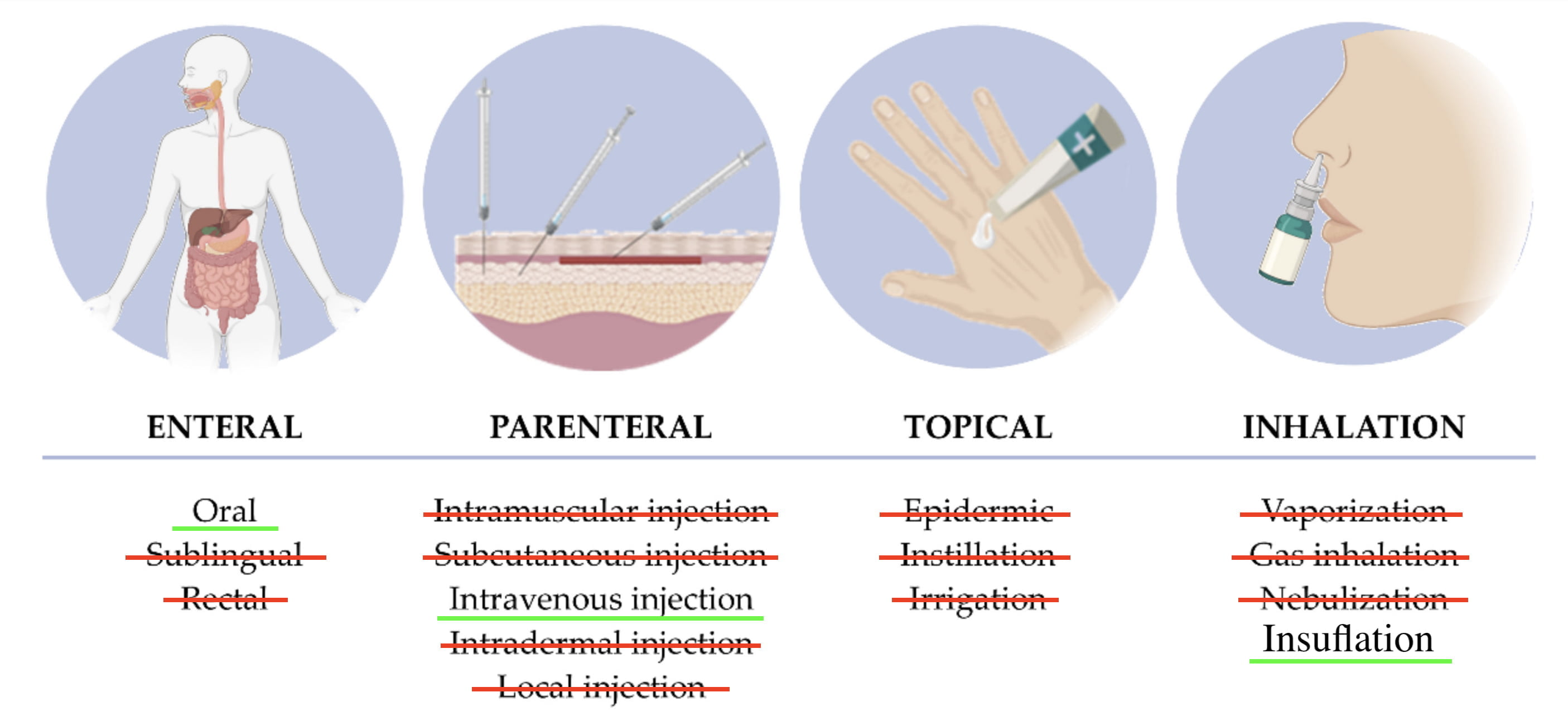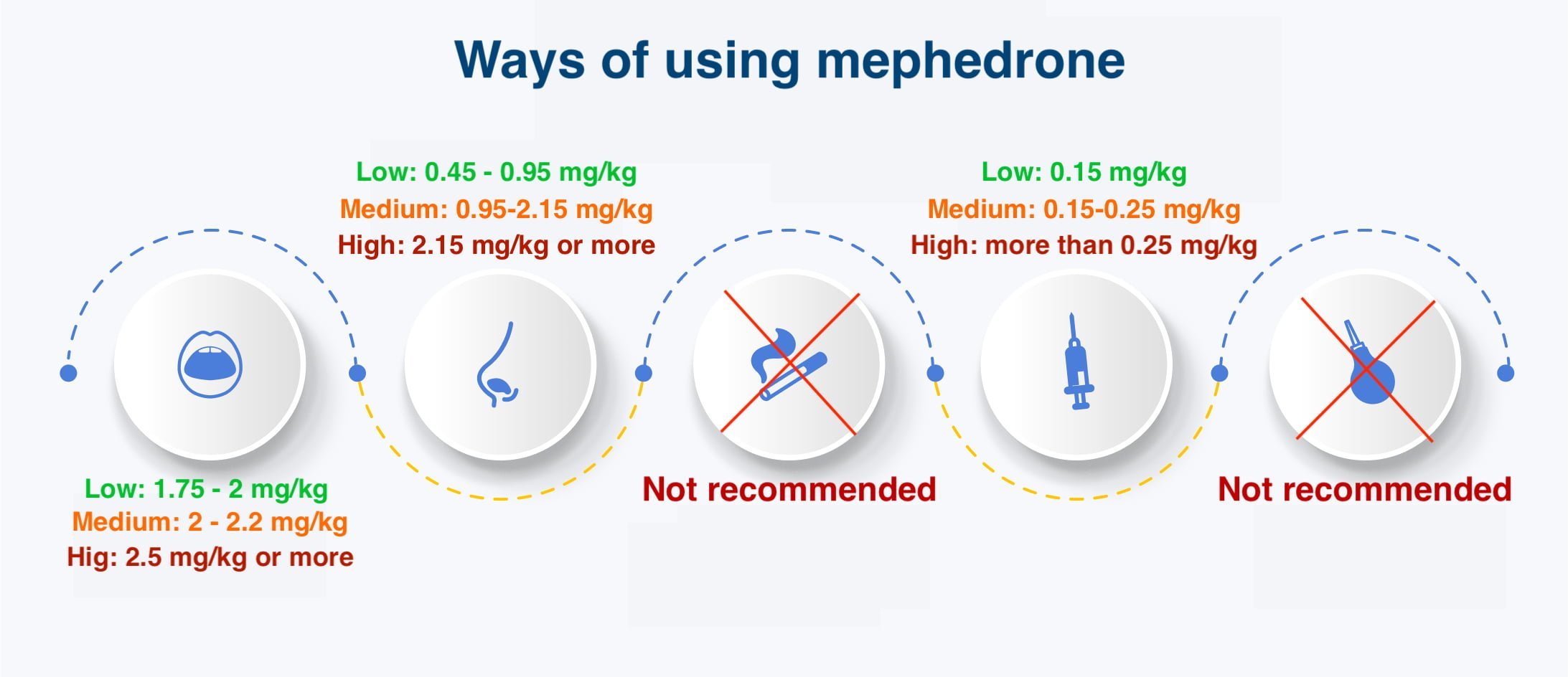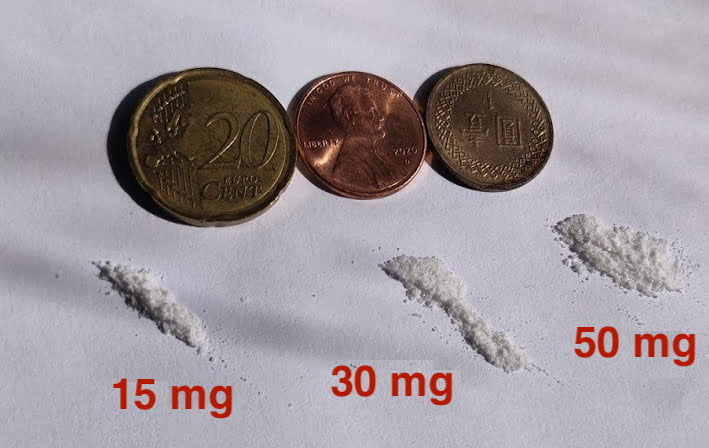Methylmethcathinone/4-Methylmethcathinone (Mephedrone; Meow Meow; Cat; Drone; Bubbles) is an entactogenic-stimulating substance of the cathinone class. Mephedrone belongs to a group known as substituted cation, which is a derivative of the active substance in the plant cat (cathinone). A research chemical first developed as an analogue of MDMA in 1929, it eventually became popular among recreational drug users between 2007 and 2009 as it became available for purchase online in dark markets. Mephedrone hydrochloride (mephedrone dose) has a characteristic smell of “dill and chemicals” (the smell of the base of 4-methylmethcathinone), and is found either in the form of a white powder (flour) or in the form of crystals (similar to sugar).
Mephedrone flour is a white floury powder with an admixture of small crystals, which can clump. This is the first product produced in the synthesis process of mephedrone (first oxidation with the base, then solvent cleaning) – an amorphous precipitate. Mephedrone crystals are colorless, transparent crystals that resemble sugar in appearance. They are obtained by recrystallization of “flour”. There are two types of crystals: crystallus-obtained with rapid recrystallization, true crystals – with slow recrystallization. Cathinones are structurally similar to amphetamines.
They contain a phenylethylamine core with a phenyl ring connected to an amine group (NH2) via an ethyl chain with an additional methyl substitution at Ra. Amphetamines and cathinones are alpha-methylated phenylethylamines, cathinones contain an additional carbonyl group on R1. Mephedrone contains an additional methyl substitute for RN, similar to MDMA and methamphetamine, and R4 of its phenyl ring – (RS) – 2-Methylamino-1-(4-methylphenyl)propan-1-one.
Other psychoactive substances that can be sold under the name of mephedrone: 4-CMC / 4-chloromethacathinone; 3/4-FMC; 4-emc; 4-CEC / Ethyl-Hexedrone / Hexedrone; 4-ma; 4-FA and 2-FA.
Mephedrone dose: How Much To Use To Avoid Danger?
Every recreational user faces the problem of individualizing the dosage of mephedrone. In most cases, the use of cathinones is carried out by imprecise calculation of the dose by the length of the “track” of crystals, without taking into account a large number of nuances (purity of the product, presence of tolerance, method of use, combination of mephedrone with other psychoactive substances, presence of diseases and so on).
Undoubtedly, 4-mmc is harmful to health and the use of this substance is associated with high risks, but if used competently, it is possible to minimize the risks and reduce the likelihood of side effects. Mephedrone can be consumed in a variety of ways: “bombs” in the form of gelatin capsules, pressed tablets, white powder (crystals), mephedrone hydrochloride solution (parenterally), smoking mephedrone crystals (ineffective and dangerous) and using a rectal suppository (dangerous). In this publication, we will discuss the main ways of using and calculating the dosage of mephedrone.
The most ideal solution is to use kitchen milligram electronic scales, as they help to achieve maximum accuracy in identifying the correct dose (taking into account that mephedrone is of high purity). If you do not have a kitchen electronic scale, you can use a hole in a cigarette filter, usually about 70–100 mg of mephedrone crystals can be placed there. Also, you can use special measuring spoons from different mixtures.
The millimeter paper method is using the distribution of mephedrone on a marked sheet, usually one quart can have about 10 mg of mephedrone crystals without a slide. As a last resort, you can use gelatin capsules of various sizes ranging from “5” to “000”; in the former case, the amount of mephedrone will be approximately 70 mg, in the latter case about 900 mg. The eye method of measuring the dose is the most inefficient and dangerous, as its accuracy is extremely low. Visually, it is very difficult to determine the difference between 20 and 50 mg of mephedrone, as the error can reach 10-30 mg.
Intranasal route of administration
Intranasal use of mephedrone involves the beginning of the effect within five minutes with standard medium doses, the plateau is reached already at 15-20 minutes, and the total time the “expected” effects last is about 40 minutes. With intranasal use, the doses are calculated according to the following gradations:
-
Low – 0.45-0.95 mg/kg;
-
Medium – 0.95-2.15 mg/kg;
-
High – 2.15 mg/kg or more.
The oral route of administration
Oral use involves the use of gelatin capsules, or mephedrone dissolved in warm water (considering the sediment of mephedrone, which doesn’t dissolve). Oral administration is the most common route of administration for most substance classes. This route allows a substance to be absorbed through blood vessels lining the stomach and intestines.
The onset is generally slower than other methods of ingestion as it must undergo first-pass metabolism through the liver. Additionally, the absorption and overall duration are generally longer as well. Given the low bioavailability of mephedrone when absorbed into the gastrointestinal tract, the dosage is usually about 1.75 mg/kg. With an increase in the dosage, the risk of severe side effects increases as well. The effect occurs within 15-20 minutes, the plateau is frequently at 40 minutes, and the duration of the effects is about 90 minutes. With oral use, the doses are calculated according to the following gradations:
-
Low – 1.75-2.00 mg/kg;
-
Medium – 2.00 – 2.2 mg/kg;
-
High – 2.5 mg/kg or more.
Parenteral (intravenous) route of administration
Intravenous use is not recommended due to its negative effects on the vessel wall and surrounding soft tissues. The incidence of phlebitis and thrombophlebitis in veins, which mephedrone solution is injected in, is 65-85%, which determines the choice of mainly intranasal use of the substance. The doses of mephedrone for intravenous injection are as follows:
-
Low – 0.15 mg/kg;
-
Medium – 0.15-0.25 mg/kg;
-
High – more than 0.25 mg/kg.
These doses are valid only for pure substance. Typically, the doses of the substance used are 20-30% higher than the ones mentioned, depending on the quality of the product, the presence of tolerance to the substance and other factors. After 3-4 times of using mephedrone in one session, there is no point to use again, since tolerance will be at a maximum, the quality of the “expected” effects and their duration will be minimal, and the severity and duration of side effects will be at a maximum. There are many reports of the rectal method of use as well as the smoking method.
Both methods are ineffective and dangerous. Rectal use is more likely to cause rectal mucosal complications (abscess, paraproctitis, rectal ulceration, and bleeding). If you use mephedrone by smoking, you will not get the desired effects. Also, the following methods of mephedrone use are not recommended: subcutaneous and intramuscular injection; smoking and vaporization; sublingual and transbuccal use.
Important
If you use mephedrone in combination with other psychoactive substances, the dose of mephedrone should be 50% less than the recommended dose, and the total amount of the substance per session should not exceed 500 mg. To see the compatibility of mephedrone with other psychoactive substances – you need to use a special guide on our website mephedrone.com
In the presence of any acute diseases, as well as chronic diseases (any mental illness, lung disease, liver, hematopoietic system, spleen, kidney, pancreas, stomach, autoimmune diseases, as well as diseases of the central and peripheral nervous system) the use of mephedrone is strongly contraindicated.
Mephedrone use very often develops compulsive dose repetition, which is defined as the experience of a strong and difficult to resist urge to continuously re-dose a psychoactive substance (mephedrone) in an attempt to enhance or maintain the subjective effects it causes.
This effect is considerably more likely to manifest itself when the user has a large supply of the given substance within their possession. It can be partially avoided by pre-weighing dosages, not keeping the remaining material within sight, exerting self-control, and giving the compound to a trusted individual to keep until they deem it safe to return. Also, you need to stop using immediately and preferably take a sedative such as benzodiazepines (alprazolam).
There should be at least 4-6 weeks break between sessions of using mephedrone to restore the metabolic processes. Intramuscular use of mephedrone is not recommended due to the almost 100% chance of developing complications in the form of inflammatory infiltrate, postinjection abscess, phlegmon of the gluteal region and other complications. Before using mephedrone, it is recommended to purify it by treatment with ethyl acetate through a chemical filter.
Three to four days before using mephedrone, it is recommended to start taking a course of multivitamins (with the B vitamins present in the composition), magnesium and potassium preparations and disaggregates. During the use of mephedrone, it is necessary to drink a sufficient amount of bicarbonate-sodium chloride water to restore the water-electrolyte balance.
Special instructions, interaction with other psychoactive substances.
- The use of mephedrone, theoretically, does not contribute to the development of a metabolic disorder. However, it increases the severity of diabetes symptoms, disrupts the control and compensation systems of regulating the glycemic profile, decreases the effect of pharmacological therapy of diabetes mellitus. Therefore, the use of mephedrone is not recommended for patients with diabetes mellitus.
- It is not recommended to use mephedrone during any acute illness, regardless of the affected system.
- The combined use of mephedrone with other psychostimulants increases the risk of severe side effects.
- The combined use of mephedrone with iMAO and SSRIs increases the risk of serotonin syndrome.
- The combined use with 25x-NBOMe and 25x-NBOH is not recommended due to the high risk of acute coronary syndrome, severe psychosis.
- The use of mephedrone together with LSD does not have a “desirable” effect, since mephedrone changes the psychedelic properties of LSD, however, there are some sporadic cases of positive reviews.
- The combination of mephedrone with MXE, MDMA, DXM leads to an increase in incidence of complications associated with severe side effects, such as persistent increase in blood pressure, hyperthermia, neurotoxicity, ischemic attacks of the brain, acute coronary syndrome.
- The combined use of mephedrone with alcohol is a potentially dangerous combination due to an increase in the duration of the psychostimulating and euphorogenic effects of mephedrone and a decrease in the degree of alcoholic intoxication, which contributes to the uncontrolled consumption of a large amount of these substances, exposing users to an increased risk of acute intoxication.
- When using mephedrone together with marijuana, the incidence of developing acute conditions is low.
- The use of mephedrone with ketamine (in low doses) together is a popular combination. The risks of developing critical conditions are medium or low, and the effect of low doses of ketamine makes the experience of using mephedrone more “hallucinogenic” and “smoothes” the undesirable post-effects of mephedrone at the comedown from the trip.
- The combined use of mephedrone and opioid receptor agonists is not recommended.
- The combined use of mephedrone with antibacterial, antifungal and antiviral agents is not recommended.
- The use of mephedrone during pregnancy and lactation is prohibited.
- The combined use of mephedrone with drugs of the PDE-5 inhibitor group increases the risk of developing cardiovascular complications with medium risk level.




